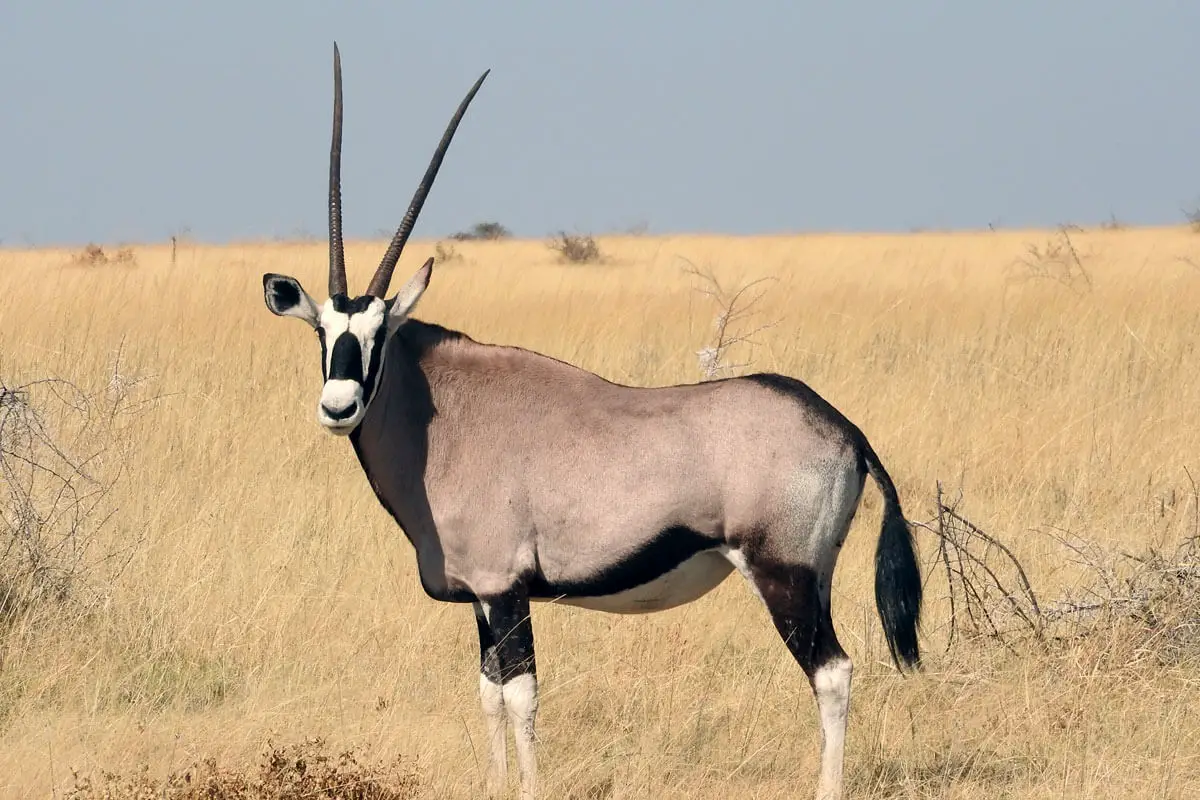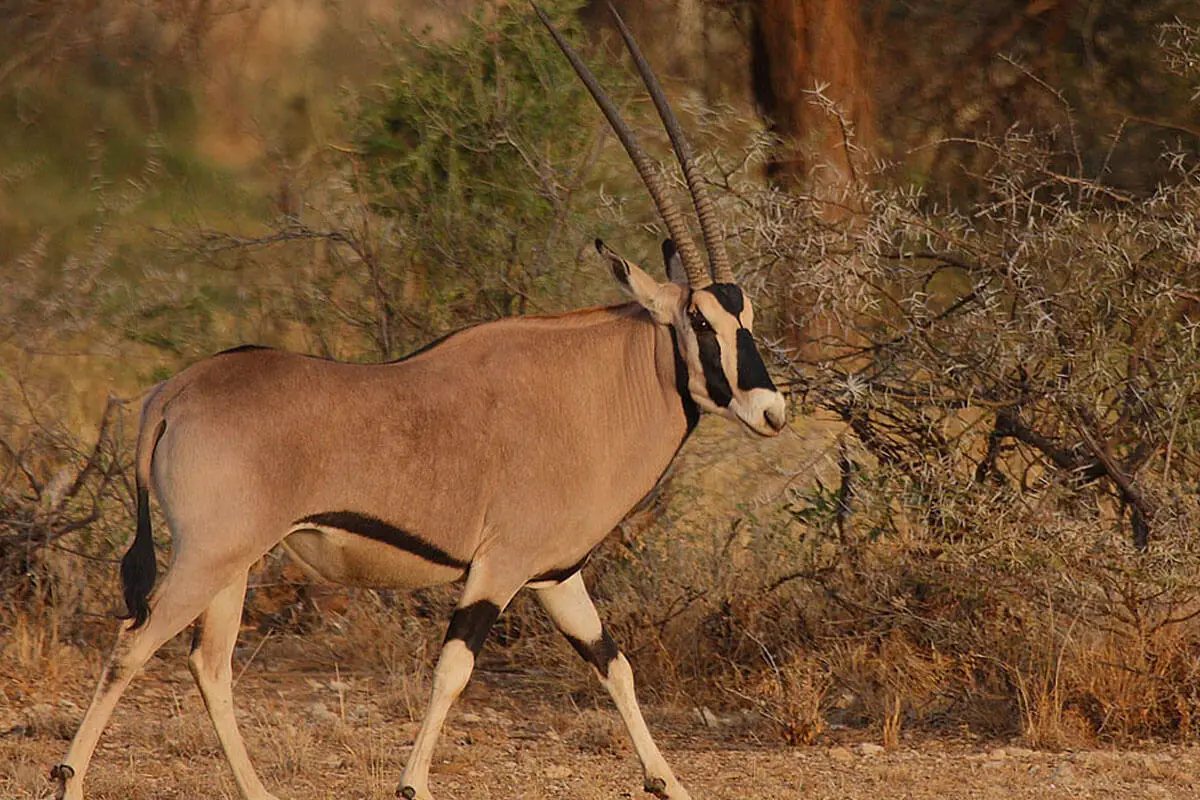The Beisa Oryx also called the East African Oryx, is a captivating and rare antelope type found in the dry regions of Eastern Africa.
Its distinctive black-and-white patterns and lengthy, slender horns are a marvel to the witness. Nevertheless, this grand animal's allure is not just skin-deep.
In this article, we shall explore the most intriguing particulars concerning the Beisa Oryx, from its resilience tactics in severe surroundings to its cultural significance for the local populace. Regardless of whether you have an affinity for fauna or are simply curious about this impressive being, the awe-inspiring world of the Beisa Oryx will undoubtedly captivate you.
Facts About Beisa Oryx
1. How Do Beisa Oryx Look Like?
Beisa Oryx is a medium-sized antelope that belongs to the Bovidae family. They have long, straight, ringed horns that can grow up to 85 cm (0.8 metres / 2.9 feet ) in length.
The Beisa Oryx have a white coat with black stripes that span their body and legs in a horizontal pattern. Since they live in the open, sunny savanna, they have black marks around their eyes to assist in decreasing glare from the sun.
The Beisa Oryx can grow to a height of 1.3 meters (4.3 feet) and weigh up to 200 kilograms (440 lb).

2. Where Does Beisa Oryx Live?
Beisa Oryx are found in semi-arid areas of Eastern Africa, including Kenya, Tanzania, Ethiopia, and Somalia. They prefer open grasslands and plains with scattered bushes and trees.
3. How Big Are Beisa Oryx?
Beisa Oryx can grow up to 1.3 meters tall and weigh up to 200 kg (440 pounds). Males are larger than females and have longer, thicker horns (up to 85 cm) compared to females (up to 65 cm).
They are comparable in size and weight to Grevy's Zebras (1.6 meters tall and weighing around 400 kg) and Sable Antelopes (1.5 meters tall and weighing up to 235 kg).
4. What Do Beisa Oryx Eat?
Beisa Oryx are herbivores and mainly feed on grasses, leaves, and fruits. They are adapted to survive in arid regions with little water and can obtain most of their moisture from the plants they eat.
5. Do Beisa Oryx Drink Water?
Beisa Oryx often drink from water sources such as rivers, streams, and water holes to stay alive. They can, however, also survive in dry areas because of their adaptations, and they can absorb water from the plants they consume.
It is a key adaptation for them to live in locations with little water supplies because they can store water in their body and continue for long stretches without drinking. Nonetheless, Beisa Oryx will quickly consume water when it is accessible and take advantage of the chance to hydrate.

6. Do Beisa Oryx Have Good Senses?
To survive in the harsh and unpredictable African savanna habitat, Beisa Oryx have highly developed senses.
Their big, pointed ears provide them the ability to hear sounds from a distance and identify potential dangers like predators or other animals nearby. They can also locate possible food sources in the open savanna and spot predators from a great distance thanks to their keen eyesight.
Furthermore, Beisa Oryx also have a keen sense of smell, which aids in spotting predators and locating water and food sources.
7. Why Do Beisa Oryx Have Long Horns?
The long horns on Beisa oryx are used for a variety of things. Their horns serve as a key line of protection against predators. Predators like lions, hyenas, and cheetahs are repelled by horns, which are also utilized for defence.
In addition, during mating season, male Beisa Oryx compete with one another using their long horns. They clash their horns together in ritualistic displays of power in an attempt to claim dominance and secure opportunities to mate with females.
Lastly, by directing blood flow to the head, a technique called thermoregulation, their long horns may also assist in controlling body temperature.
8. How Fast Is Beisa Oryx?
Beisa Oryx has a top speed of 60 km/h (37 mph). They can sustain their great pace for an extended amount of time and are well adapted to running on the challenging African savanna terrain.
Speed and agility are essential for avoiding predators like lions, leopards, and hyenas while engaging in open-range feeding on the grasslands.
8. Are Beisa Oryx Social?
Like many antelopes in Africa, Beisa Oryx are highly social and live in groups of up to 40 individuals. These groups, also known as herds, are usually led by a dominant male and include females and their young ones.
9. How Do Beisa Oryx Reproduce?
Beisa Oryx reproduce sexually, with males competing for mating opportunities with females. Females give birth to a single calf after a gestation period of about 8 months. The calf can stand and walk shortly after birth and is weaned at around 6 months old.
10. How Long Do Beisa Oryx Live?
Beisa Oryx typically live up to 20 years in the wild. However, their lifespan can vary depending on various factors, such as predation, habitat quality, and availability of resources. In captivity, Beisa Oryx have been known to live up to 24 years.
Compared to other African animals, the lifespan of Beisa Oryx is relatively long. For example, lions, which are one of the top predators in the African savanna, have an average lifespan of around 10-14 years in the wild.
Related article: Comparing the lifespan of African wild animals
11. Is The Beisa Oryx Threatened?
Beisa Oryx were once abundant in their natural habitat, but their numbers have declined due to hunting and habitat loss.
They are currently listed as Endangered by the International Union for Conservation of Nature (IUCN) Red List. Conservation efforts are underway to protect and conserve their populations. Travel and tourism to the parks where these animals live contribute to helping in the conservation of the ecosystems.
Final Thoughts
Beisa Oryx are fascinating creatures that have adapted to survive in harsh environments. However, their populations are under threat due to hunting and habitat loss.
It is important to continue efforts to protect and conserve these magnificent animals to ensure their survival for generations to come.
